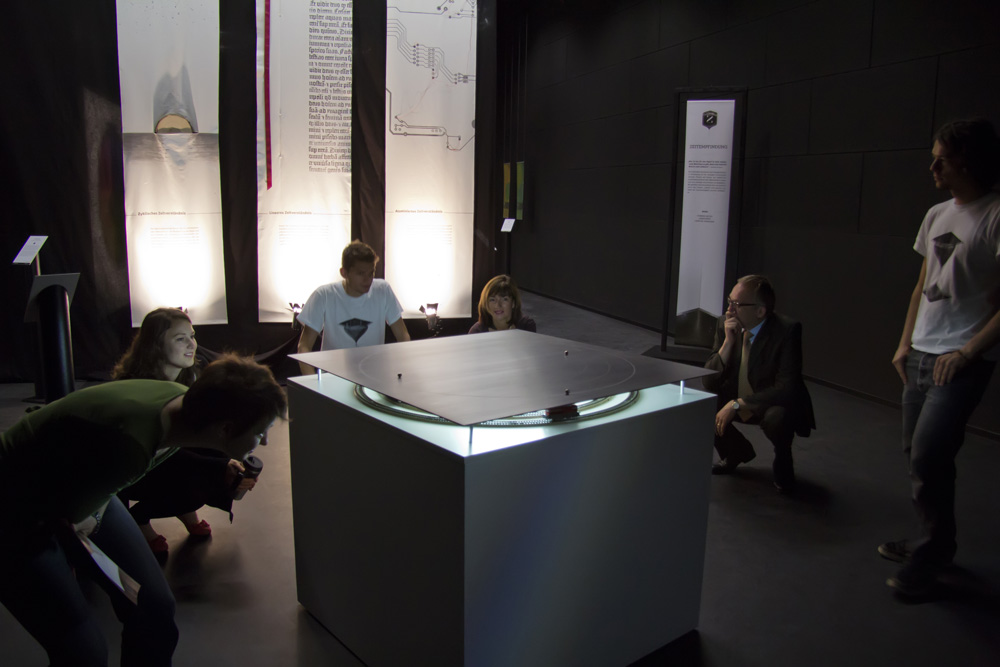
You have your clocks, we have the time. But time is relative. There’s no substitute for taking time, even when it’s running like sand through your fingers. Is my time more valuable than yours? Lifetime, cooking time, Christmastime, prime time. Full-time? Time is something that determines everyday life, characterizes it, divides it up into quantifiable, measurable units, establishes a beat to which we’re all supposed to march to. We have atomic clocks that tell us with the utmost precision how long a second lasts. We have schedules for trains, streetcars and busses. And we have working hours. We know exactly when the screening of a feature film is set to begin, and when the sun will rise tomorrow. You could conclude that we have time under control, but we’re still incapable of influencing it. Though it seems to conform to objective parameters, time is different for each individual. The new exhibition opening on December 6th at the Ars Electronica Center is an in-depth encounter with time—what we do with our time, how we perceive it, how it influences our lives. Time Is Hero—time is what it’s all about! It’s a resource that’s infinite and nevertheless always in short supply.
The exhibition can essentially be divided into three parts, thematically interrelated but each focusing on different aspects of time. These core domains are entitled Time Structures, Perception of Time and Organizing One’s Time. They contain nine installations that invite you spend some time coming to terms with time.
Time Structures

The Train of Time installation is representative of these confrontations with time structures. When the railway was invented and the Industrial Revolution really got up a head of steam, it became necessary to coordinate the measurement of time and the time of day at different locations. Even if one occasionally gets the impression nowadays that this hasn’t been a total success, it was nevertheless an achievement of fundamental significance to synchronize the time of day—first in all of a country’s villages and cities and then in other lands and continents—to make integrated train scheduling possible. The Train of Time takes a metaphorical approach to this development. Three model railroad trains represent, respectively, seconds, minutes and hours. Each tows a magnetic ball behind it as a graphic depiction of the synchronization and, in a way, abduction of time.
Perception of Time

In the section dealing with how people personally perceive time, a visitor can consider the pace of his/her own life. According to American psychologist Dr. Robert Levine, this is essentially determined by five factors: economy, industrialization, population, climate and cultural values. In the installation, these five factors can be varied. One sees the pace of one’s own life depicted as a circle and this can be viewed in relation to people in various other countries. The higher the degree of correspondence between the pace of one’s own life and that of the particular country, the more the boundaries get blurred, and vice versa.
Organizing One’s Time

This part of the exhibition scrutinizes how we budget our time. Here the focus is on issues like work-life balance. One highlight is the Moments and Strawberries installation—five very personal situations seemingly extracted from the flow of time in which a person, despite being pressed for time, takes the time to arrive at a perceptive insight. The individual seems to be at the center of a maelstrom and yet impervious to the mad rush and stress. It’s as if he/she had taken leave of space and time.
Time is Hero opens on December 6th at the Ars Electronica Center. Make time to check out this timely exhibition! For instance, to chat with the interesting young people who created it: Thomas Altmanninger, Marlene Eggenreich, Tobias Furtschegger, Friederike Krepela, Vinzenz Mayrhofer and Thomas Mühlberger. Also take time to browse through the pictures on Flickr.